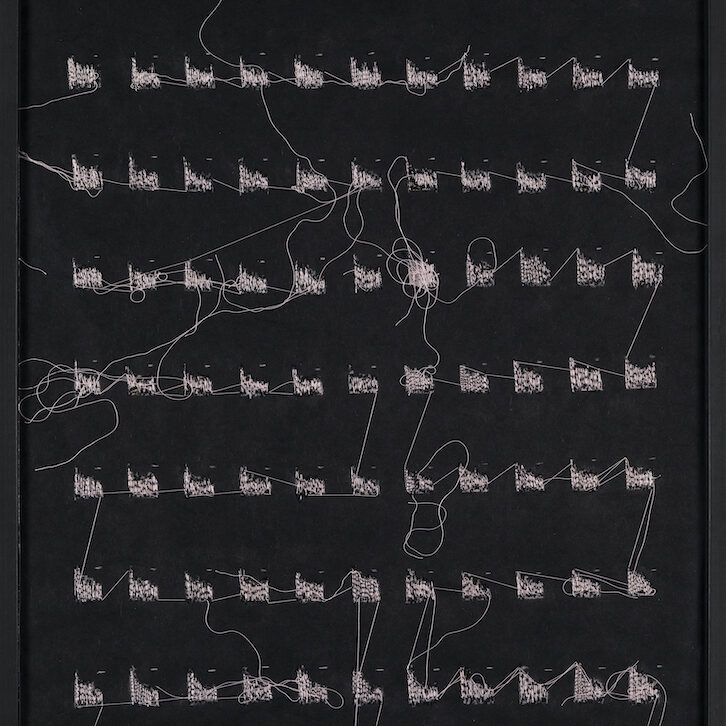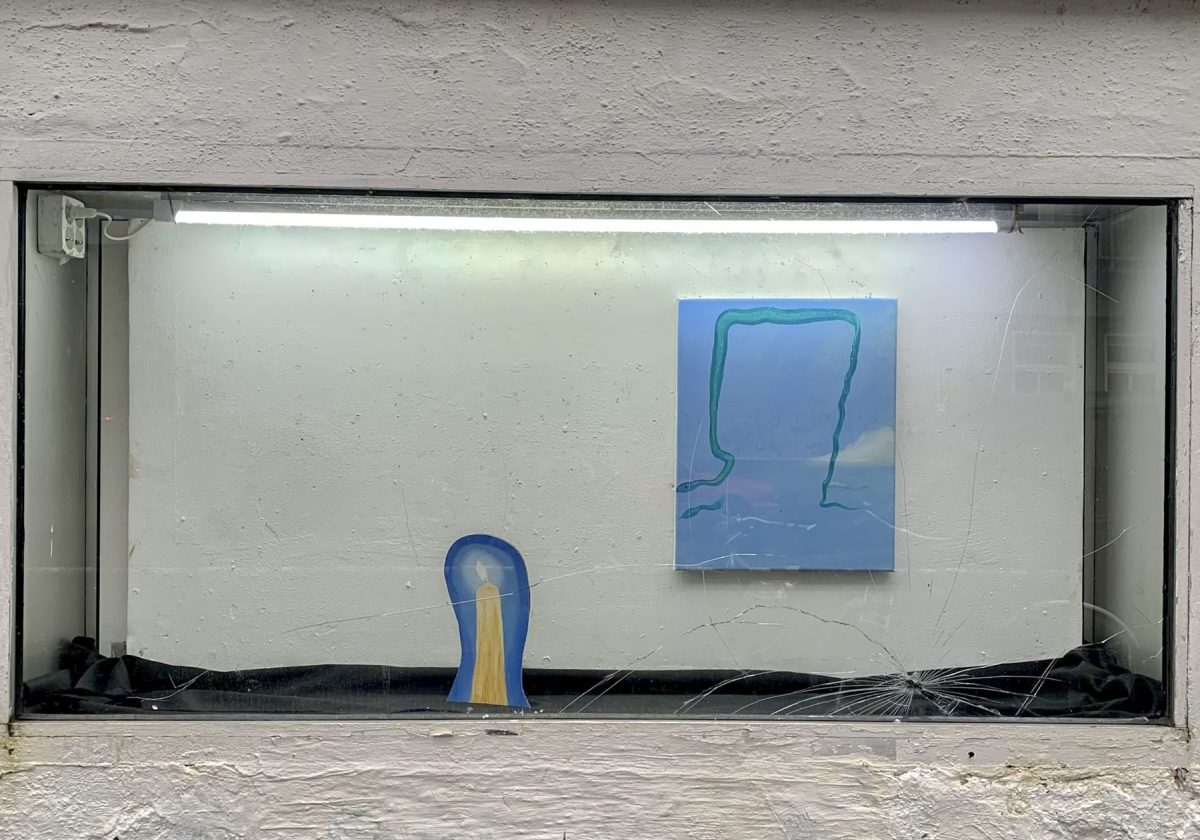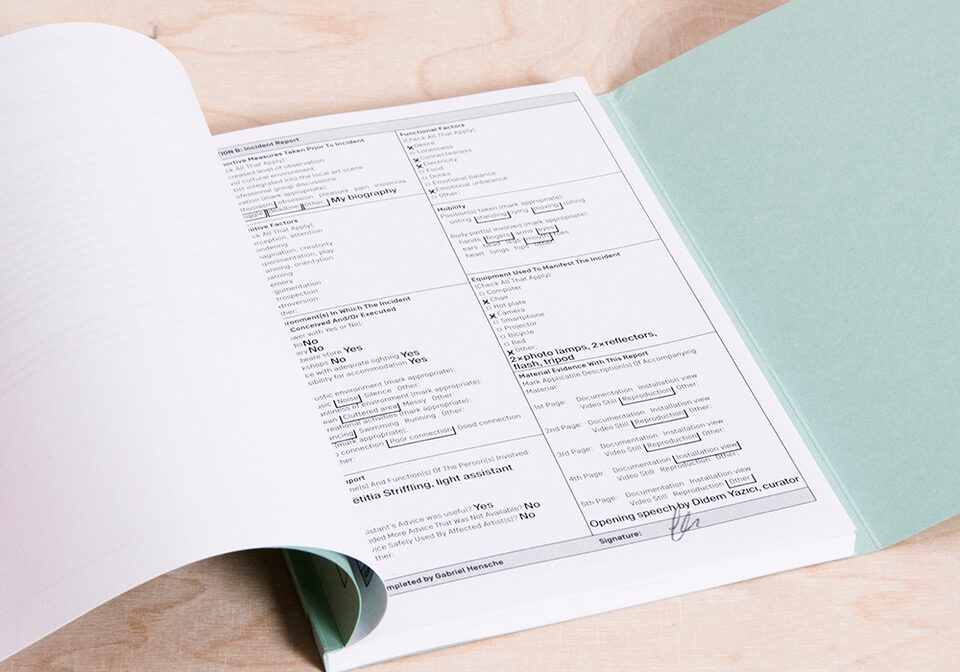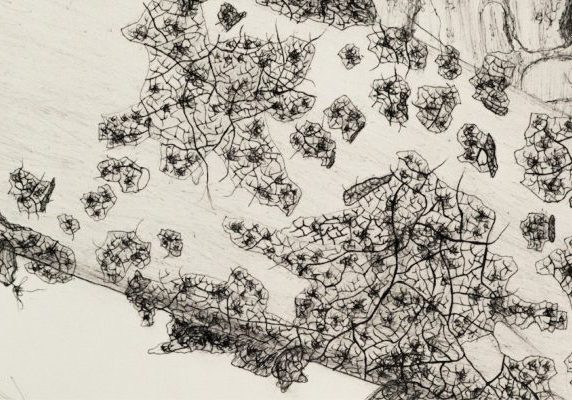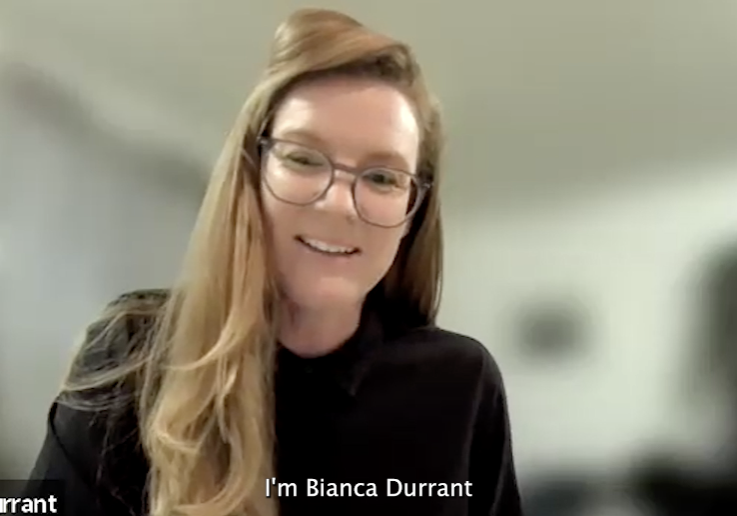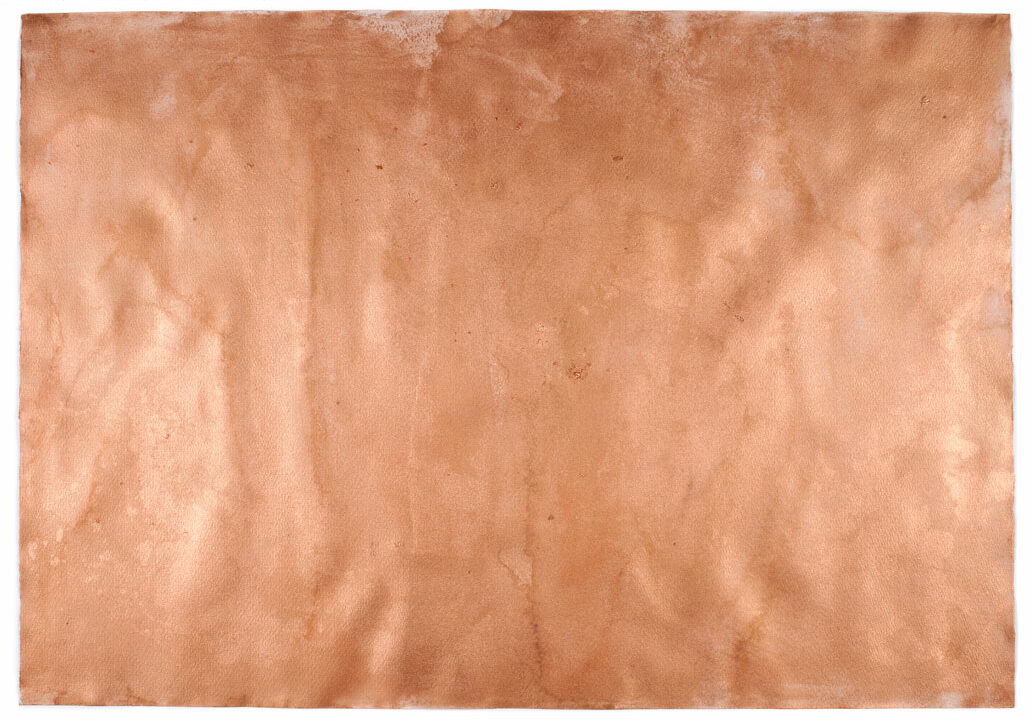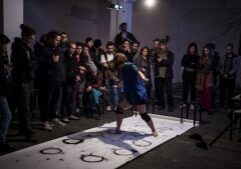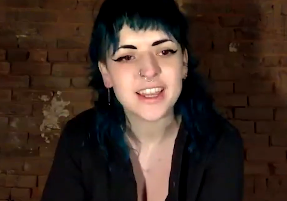Meet the Artist // Sofia Mendiondo
Sofia welcomes me into her studio, articulately dressed to match both the fashion of the city, and honor her own personal style. I walk into her room and I am greeted by enticing, strange materials dripping from the walls, faintly reminding me of a dream catcher. Black dots pepper her studio floor, all made out of a strange solid/liquid material, screaming to be touched.
A few minutes later we are settled, delving into the materiality of her work, and her obsession with the mysterious world of dreams.
What brought you here to GlogauAIR?
It was the residency. I was going to go to Leipzig for another residency, and then I learnt about GlogauAIR and then I decided to come here. I really love the city. For me it’s also really important to see a lot of art and different types, and there is certainly a lot of opportunity to see these kinds of things in Berlin.
I agree. I feel that everyone that wants to can explore and they can show their work in any place at any time, and there are so many great abandoned buildings which make excellent exhibition spaces.
Not commercial either, or elitist. It has been refreshing to discover somewhere free. I have realized I can do my things I really want to with my work.
How did you stop using the breast implant material?
I started quite a while ago. I have been collecting them for about 15 years .
My father is a plastic surgeon so I was in contact with them from a really young age, and they always called my attention, my eyes always wandered towards them. I asked my dad if he could give me the ones that are unused. The ones that I saw, and have collected, were always taken from the bodies of women who no longer needed them. They were seen as trash because people cannot use them again, but I saw this potential in them.
For a long time I just collected them and kept them in the box. Until a few years ago I started to get them out, to question what I want to do with this amazing material. It was a really slow process. I started by dissecting them and introducing some threads on it. At a certain point I was like okay, why am I breaking? I love them just the way they are.
So instead I started using video to register them. Capturing the movements they made and then I started doing little choreographies between some of them, and then placed them in water. Then in the human body to measure resistance and equilibrium. I started to be connected to them. It’s impossible to travel with them, they are really really heavy. So it’s a work in process all the time.
So your fascination is about video, because if it’s not about showing them, what is it?
No, it’s about being obsessed. I don’t know if fascinated is the word. I’m really attracted to the material. For me, they are preachers, they are invertible creatures. And I’m really attracted to the material and not like plastic surgery.
So It’s more about the materiality
Yes, my interest is in taking a material from its complexities. They are traditionally part of plastic surgeries, but they can be something else. When you video sometimes this becomes more apparent, and it has been amazing to see the materials outside their traditional role.
You’re interested in exhibiting them in a way and taking them out of their context?
Yeah, of course,. they are oppressed if they are left unused. I want to extract the material and use it in a way that allows it to be productive.
Does it interest you that they were in a human body?
Yes, and the fact that these materials were alive.
It’s really interesting, because I have a lot of questions about body memory. Objects have body memories. For 20 years these materials are inside the body. I am interested in what they get from there, for so long they were in contact with neurons, cells, and blood. They were all the time in contact with these basic bodily things. So for me, they are suspended in a kind of bodily choreography. I like to think about what they get from the body and somehow capture this is how I use them outside the body.
I guess that kind of goes into your work with dreams?
Yes, that really goes into it for me, it’s really connected.
How did you kind of get into investigating dreams?
I really got into dreams when I was really little. Some months ago I found a text I wrote when I was 11 years old called dreams. It was a text on which I put dream examples and tried to justify why that was a dream and not a wakeful state. I was playing the dream detective. So I think it was born really early.
Dreams can be quite surrealist?
Yeah, and I was really investigating this at the time. I was interested in hearing the dreams fro other people. Then I started studying psychology, I think, because of my interest in dreams. I really like to take note of my dreams from a long time ago, and I still do this now. Every time I remember them, even if it is only one scene or two words. I take note of the date.
I have a really long diary now. Around 70 pages of just dreams.
Do you ever read them back? Yes,
I have made a sewing work out of some of them. I would look at a page in my dairy, then articulate the most common verb I had used to describe a dream. Then, place those at the top of the piece and move down by concentration. The piece is called awareness.
How long did that take?
It was with a sewing machine. But it took me a long time. It’s three meters by two meters. So it’s really big. I like finding words and repeating. I’m interested in repetition, and the amount of time a dream is repeated between different people. This is also what the website I am creating is for, to track dream repetition.
I was quite interested in the dream website. You’re going to make it, would you explain a bit more?
The Dream Incubator, functions as a digital platform where people can enter their dreams and interact with them. Built on the repetition of words, the project aims to encourage the remembrance of dreams, their potential impact on us, and to create a collective archive of dream experiences.
You will have your user ID and password and You login and your space where you record your dreams. There are three ways to interact with your subconscious world. One is to extract a repeated word you like, then there is also the ability to throw the dreams you are exhausted with away. I am hoping to expand the interaction in the future.
So it allows you to play with your dream? Yeah. You people go on right down the dream they have had and then they can play with it?
Yeah. Then you have your dream archive, you have your diary organized. You will have information about the symbolism also. The idea is also aimed to generate a collective archive of ordinary life. A record of what people dream in 2023 compared to 2020 ETC.
I want to investigate Historic factors that happen using dreams, and bring new information on how different events affect the subconscious. Especially during events like COVID. I was listening to my friends, my patients. All of the words were new in 2020. I don’t know how these will then affect our dream scapes but I am interested to find out.
As you said, You did psychology.
Yeah, I studied and I worked five years in a hospital.
So how did you get into art?
I think I never went away from it. I studied fashion design for some years. I am also always doing textiles or art workshops. Then I started studying contemporary art through these workshops. So For me art is something that is always present one way or another.
And how did you move into more sculptural art, because you did a lot of textiles before
I don’t know, I think I’m just discovering something about my work. When I have an idea of something then I want to search for the medium of it. I realized sewing does not fit with all of my ideas. I did that at the beginning. I was passing my idea into the sewing machine. I have these interesting dreams. I realized I didn’t necessarily want to attach to textiles.
So then I started to ask what? What material do I need if I want to think about the substance in dreams, what they are made of? I don’t know. Maybe they are not meant to be made with sewing. They were more jelly things. Things that will disappear.
So you found a new material.
Yeah, to express an idea. Because they’re quite bodily. I was inspired by my breast material because I wanted to make some bigger and change some to smaller.
I started thinking about my dreams. Maybe I have repeated dreams, or a repeated dreaming sensation. Things get smaller and bigger all the time, maybe I wanted to remove something, or add two dreams together. The material of the breast prosthesis felt like something which could achieve this.
Do you sort of play with your own dreamscape?
Yes, now I started playing with my own dreams, in other ways as well that are not just based on words.
Yes, because sculptures can take different shapes.
For me, they are different shapes, because there are differences in dreams. They are subconscious landscapes which transform all the time. I like to play with that also. I was interested in what they are made of. Dreams are never the same. They are made of the same material, But they have different forms. I like to play with that person.
Because you’re also a psychologist Do you think that affected your work a lot?
Oh, yes. Especially my work in the hospital. I worked for five years and a half, and from nine to five in the hospital. So yes, it was a big inspiration for me. A sewing machine and being psychologists are both are big reference points.
Because I feel like dreams are very psychological. Some people think their dreams have meaning. I think you dream about things that you worry about.
Yes. In really cryptic ways. That’s like the aim of the webpage, to give to us or to give people an insight into something about the intelligence of dreams. To start really being connected with them because they are really important. They can save our lives. Especially If you hear them, and if you start to listen. Sometimes I realize dreams tell us things, then we have to respond to help us achieve happiness in reality.
Do you kind of analyze your own dreams a lot?
Yes, I like to talk about a lot of my dreams in therapy. And yes, it’s a big place I analyze because I think that they are more intelligent than me. So I started getting into looking at dreams. I’m not like analyzing it in terms of this means that. This is where repetition comes, it’s like, okay, what am I dreaming of all the time? I’m not so much interested in the symbolism, but more the core subject, and I think repetition really highlights the fundamental meaning of the dream.
This is what is telling you something.
Was it difficult to move into using sculpture? because obviously you did a lot of textiles based things. Was it difficult to move into using a new material?
Yes, it was. Sometimes I was like, Okay, why? Why have I decided to change this now?
Do you think you’ll go back to textiles?
Yes. It’s what I said before, I use videos. So for me, the medium it’s a way of transmitting something. It’s not like I’m married to one form of media. If I need a video because I want to hear a voice, I will use video. I always do things where I like to put voices on them or frames, if I need the voice, I need the voice. If I need the video because I want to register the best practice, I need the video. Maybe the video had more body than the materiality of sewing.
This material I use here, during the residency, is very bodily. I don’t think you can achieve the same with sewing.
I was interested in starting to think about materials and composition. I don’t also have this guilty consciousness about waste. With sewing, it’s a lot of thread,or a lot of paper. Why are we producing so many things, and why am I using so many things? Maybe if I fit some materials with less waste, but then it could take years. I’m really interested in using less material. `here is not a laboratory. So I’m dealing with this issue as well.
Does the inspiration behind this material come from the breast prosthesis?
Yeah, I was really searching. I try with different formulas to make the materials. And I was really searching for something that has a protective layer, but inside was more wet. I’m happy because I think I found something that is effective, and fits what I was looking for.
What are some key moments that have shaped your artistic career?
I think the one was when I was starting to do clothes. One of my teachers told me, ‘you are not interested in molding’. You don’t want to waste your time. You like to be using the sewing machine, but you are interested in literally drawing with a sewing machine. So you should investigate this. Everything you want to interpret, interpret with textiles. I realized, Whoa, yes, it’s true. So I started using the sewing machine to draw, not to make clothes but to draw in a different way. I was really into it. Then I started being interested in procedures implicated in the use of the sewing machine, and procedures implicated in the machine. So I started filming the needle and recording the sounds of the sewing machine repeating each stitch.
So you drew with it, but also made videos out of it.
Yeah. So that was already important. On this one also, because I changed material or material. Now I am open to that formula that it has become more a question of what media can I use to transmit this? If I need video, I need a video. If I need to use video. I don’t know, I never painted but if I need painting, I will use paints.
You started to see like, the art world is everything rather than just one, you’re interested in the concept. And material will fulfill the concept rather than having a material first.
But I really like materiality because it gives me a lot of things. It was like when I started doing this, I was thinking I was only going on to breast prosthesis. And then I started experimenting. I thought the threads could be thicker if I used another thing and then I got tied to it, and it gave me materials that started to give me new ideas all the time. I love that about getting into materials. They start to give ideas when I start working with them.
What are some key elements in your process as an artist
Maybe to be all the time thinking about it with something to write just like all the time for me it’s worth it and thinking of new ideas. On other subjects I think that it’s really important for me, getting into what materials and what materials can give me. That is really important in my procedure. To relate things. I work in the hospital and I started seeing electrocardiograms, which also became interesting for me.
I found some information about this paper, then I did some prints with the paper. Just getting information from different areas of knowledge. That is the most attractive and important thing in my work.
Do you think all your work sort of relates to dreams?
Not in an intentional way. But underneath I think they do.
How do you overcome moments when your creativity is not flowing? How do you resinspire yourself?
In making new associations, writing, participating in groups of artists to help me think about different things. I think I find more trouble on finishing words, not on ideas.
What is some of the best advice you have ever received?
When I am neurotic, ask why and for what reason. And then just to do. Something, anything, but just to do. From a tutor and Eva hesse.
*
Sofia’s artistic practice is grounded in the two trades that makes her formative journey: psychoanalysis and sewing, which have led her to delve into concepts such as repetition, variation, measurement, series, point, and cut.
Her current research line is focused on dreams as archives and psychopathological diagnoses, as part of a project called dream x insight, which employs data processing, sewing machine as translation tool, and the creation of a website with artificial intelligence. She also investigates embodied memory in certain movements of the human body and in a specific object – unused breast prostheses – using video for recording and documentation.
Sofia has been a resident artist at GlogauAIR since April. To find out more about her work, follow the links below.
Website: http://sofiamendiondo.com/
Instagram: @sofiamendiono_

